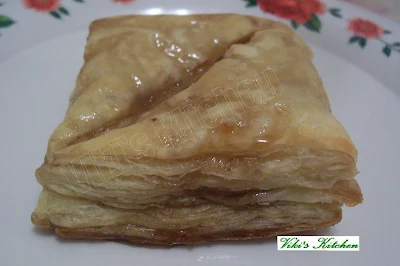Some time ago I prepared this malai kofta curry with the help of Sanjeev kapoor's and Vah chef's recipes. I used Sanjeev kapoor's version as it involved lesser vegetables but followed vahchef's instructions. His videos made me understand the difficulties in keeping the koftas in shape while frying (yeah, that's a big challenge here!). Click here to see the Vahchef's video. Thanks to the two great chefs, I have learned to make a famous Indian gravy.
| Malai kofta dough prepared. |
Ingredients:
For kofta:
Paneer (shredded) - 1 cup (100 gm)(I made it at home by using 4 cups of 2 % milk).
Potato (3 numbers,boiled, peeled and mashed) - 2 cups (200 gm)
green chillies -4
All purpose flour - 1/4 to 1/2 cup
cashew - 4
raisin - 20
salt -to taste
oil (to deep fry) - 1 cup
Pressure cook the potatoes, peel and mash them.
Mix the crumbled paneer, finely chopped green chillies, broken cashew, raisin, salt and mix well.
Add all purpose flour (maida) little by little to get a thick but soft dough.
Knead well and keep aside.
 |
| Koftas before frying. |
Now keep 1/2 cup of all purpose flour in a separate dish.
Take a small (strawberry size to lemon size) ball of dough. Make a spherical shape and dip it in maida flour. Then carefully pat to get a bullet shape.
Keep aside.
 |
| Koftas are fried now . I made a big batch and froze 2/3 of the above for further use. |
Heat a wok with 1 cup oil and deep fry the cheese koftas carefully in low fire. They may tend to break if the dough is not proper. Otherwise we will get the exact shape.
( Keep in mind how the cheese on pizza melts with temperature. Likewise paneer is nothing but a kind of Indian cheese and hence it will also tend to disintegrate while frying. So flip very carefully. Fry only one and check for the consistency. If needed add more all purpose flour to get a very thick dough, like the chapathi dough. Moreover the whole frying process should be done in very low flame).
Fry all the paneer koftas and let them cool. While hot, they will be soft and can be easily broken. So wait till they cool.
After cooling we can freeze the koftas and use whenever required.
 | |
| Malai kofta curry with a dollop of cream. |
For curry:
onion - 1 cup (chopped)almond, cashew - 5 each
tomato - 2
cilantro , mint - handful,each.
garam masal powder - 1 tsp
red chilly powder - 1 tsp
ginger garlic paste - 1 tsp
salt - to taste
milk - 1/2 cup
butter - 1 tbsp
whipped cream - 2 tbsp
Method:
Microwave or cook the onion, tomato, cilantro, mint with 1/4 cup water, let cool and grind along with cashews, almonds to a fine paste.Heat 1 tbsp butter in a wok. Put the bay leaf followed by the ginger garlic paste. Then add the puree and saute till raw smell vanishes.
Add masala powder, red chilly powder, milk, salt and bring it to a boil.
Check the taste and keep aside.
Before serving reheat the gravy and drop the prepared koftas. Top with the whipped cream.
Serve carefully without disturbing the koftas.
Serving suggestions:
Serve as side dish with any Indian bread like naan or roti.Makes 25 small size koftas.
Tips:
Generally people add koftas to the curry just before serving, to avoid broken ones.I found that the koftas if prepared carefully stays in shape for 4 to 5 hours in the gravy, just like restaurant ones . But microwaving the whole dish may make the koftas crack, so if needed heat in stove top without stirring.
Do not defreeze them in microwave. Just leave them in room temperature or drop in hot gravy.
















































